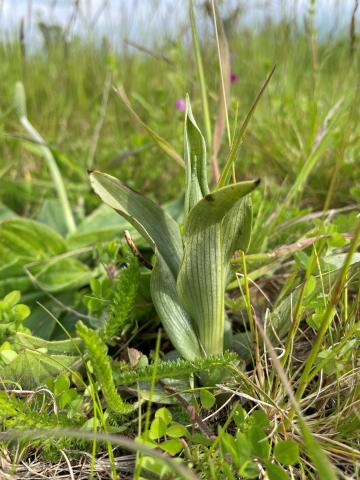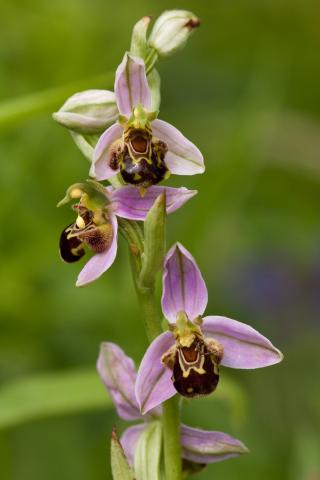
We’d like to create a buzz about Bee orchids Ophrys apifera for our late spring/early summer Look out for survey.
This striking insect-like wildflower isn’t a common species but is one of the most widespread of the orchids.
A perennial herb whose flowers are presented in a way to imitate a female bee feeding on three pink petals, with a scent that copies her pheromones in order to attract male bees for pollination. Despite this clever mimicry this plant is primarily self-pollinating in the UK and each flower produces thousands of dust-like seeds that are dispersed by air.
Historically found in chalk downland, coastal dunes and damp meadows and pastures, they like bare ground to colonise and can also be found along urban road verges, waste/disturbed ground and gravel pits.

Look out for their diminutive flower spikes from June to July.
A rosette of leaves at ground level with two long elliptical pointed leaves that grow up the stem as a sheath.
The plant can measure around 10 to 40cm tall with the stem displaying a varying number of relatively large flowers.
The flowers have pink or greenish-pink sepals that look like wings, and furry, brown lips that have yellow markings on.
Flowering can be rather sporadic. In some years they may appear in large numbers, and in others seem to disappear. Some plants may only flower once in their lifetime.

Bee Orchid sightings can be submitted via the Northamptonshire Biological Records Centre (NBRC) using the form below. As there are other species of orchids in the UK, photos are important to confirm the identification.
Before submitting your records, please read the NBRC Privacy Policy and NBRC's record submission Terms and Conditions.
If this is your first record submission, please read our quick guide to Using the NBRC Website to Submit Biological Records.
If you would like to submit more than one sighting or plan to submit sightings on a regular basis, please create an account before you submit your sightings. You will then be able to view, edit and download all your submitted records.

